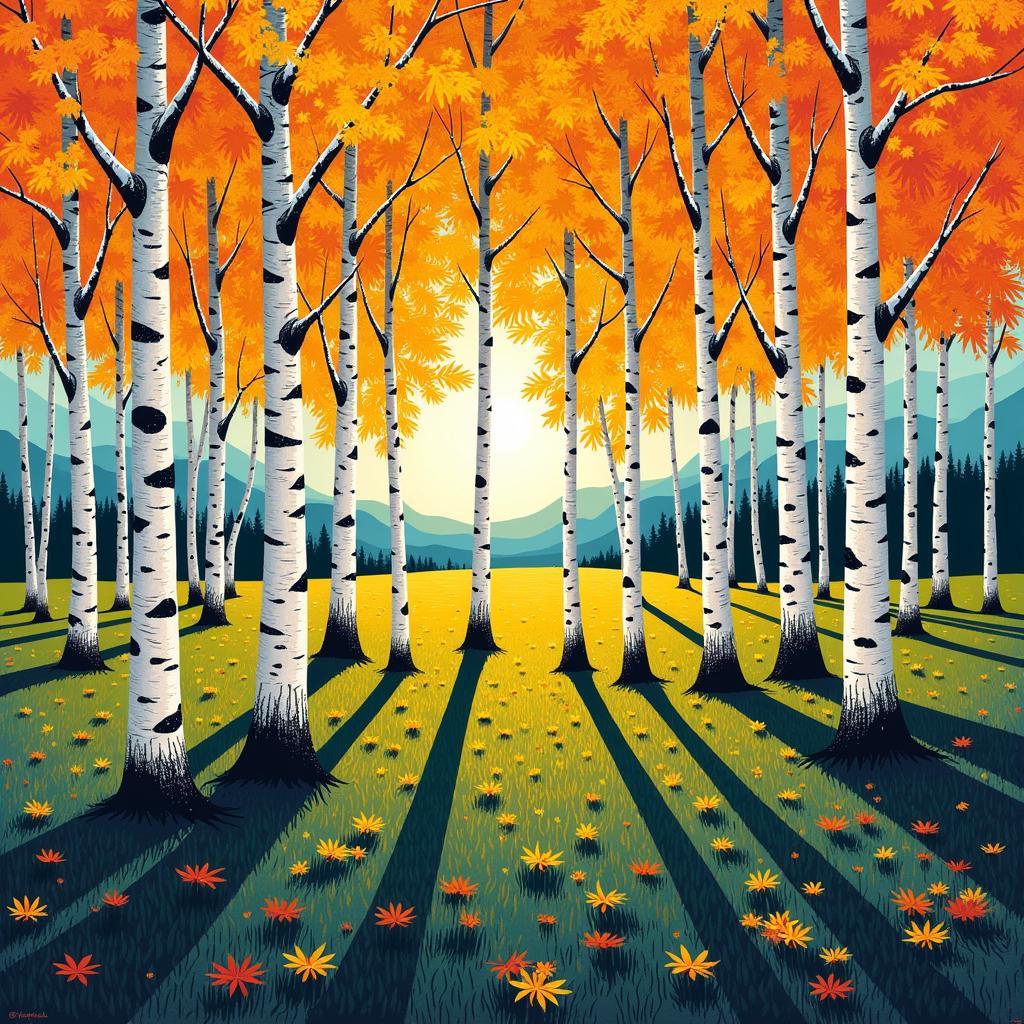Japanese Birch Tree Artwork captures the delicate beauty and enduring strength of these iconic trees. Revered in Japanese culture for their elegance and resilience, birch trees have inspired artists for centuries, resulting in a rich tapestry of artistic expressions.
The Significance of Birch Trees in Japanese Art and Culture
In Japan, birch trees, known as “shirakaba” (白樺), hold a special place in the hearts of many. Their white bark, often marked with distinctive black stripes, symbolizes purity, renewal, and the transient nature of life. They are often associated with winter, as their stark beauty stands out against the snowy landscapes.
Literature, too, has played a significant role in solidifying the birch tree’s place in Japanese consciousness. Poets and novelists have frequently used the shirakaba as a motif to explore themes of love, loss, and the passage of time. One notable example is the poet Kenji Miyazawa, whose works often feature birch trees as symbols of hope and resilience in the face of adversity.
The Many Forms of Japanese Birch Tree Art
The depiction of birch trees in Japanese art is remarkably diverse. From traditional woodblock prints and ink paintings to contemporary sculptures and photography, artists have explored various mediums and styles to capture the unique essence of these trees.
Woodblock Prints: Capturing the Essence of Nature
The art of woodblock printing, known as “mokuhanga” (木版画), reached its zenith during the Edo period (1603-1868). Artists like Hiroshige and Hokusai often incorporated birch trees into their landscapes, showcasing their distinctive forms alongside mountains, rivers, and human figures. These prints, with their vibrant colors and intricate details, offer a glimpse into the natural beauty that captivated these master artists.
 A woodblock print featuring a birch tree forest in autumn.
A woodblock print featuring a birch tree forest in autumn.
Ink Painting: Embracing Simplicity and Elegance
Japanese ink painting, or “sumi-e” (墨絵), emphasizes minimalism and spontaneity. Using only black ink and variations in brushstrokes, artists create evocative images that capture the essence of their subjects. Birch trees, with their stark contrasts and graceful forms, are particularly well-suited to this style. A single brushstroke can convey the smooth texture of bark or the delicate curve of a branch.
Contemporary Interpretations: Pushing Artistic Boundaries
Modern and contemporary Japanese artists continue to find inspiration in birch trees, often reinterpreting them through abstract forms and unconventional materials. Sculptures, installations, and even digital art offer fresh perspectives on these iconic trees, reflecting the evolving artistic landscape of Japan.
Why Japanese Birch Tree Artwork Resonates
The enduring appeal of Japanese birch tree artwork lies in its ability to evoke a range of emotions and associations.
- Connection to Nature: In a world increasingly dominated by technology, these artworks provide a visual reminder of the beauty and tranquility of the natural world.
- Symbolism and Meaning: The rich cultural significance of birch trees adds layers of depth and meaning to the artwork, inviting viewers to contemplate themes of renewal, resilience, and the passage of time.
- Artistic Mastery: The skill and artistry displayed in these works, from traditional techniques to contemporary interpretations, are a testament to the enduring legacy of Japanese art.
Conclusion
Japanese birch tree artwork offers a captivating window into the country’s cultural heritage and artistic sensibilities. From traditional woodblock prints and ink paintings to modern interpretations, these works continue to captivate and inspire audiences worldwide. Whether you are drawn to the delicate beauty of a traditional ink painting or the bold statement of a contemporary sculpture, Japanese birch tree artwork offers a unique and timeless appeal.
FAQ
- What is the significance of birch trees in Japanese culture? Birch trees symbolize purity, renewal, and the transient nature of life. They are often associated with winter and are frequently featured in Japanese literature and art.
- What are some common mediums used to depict birch trees in Japanese art? Common mediums include woodblock prints, ink paintings, sculptures, and photography.
- Where can I find Japanese birch tree artwork? You can find these artworks in museums, galleries, and online platforms specializing in Japanese art.
Need Help?
For any inquiries, please reach out to us at:
Phone Number: 0902476650
Email: [email protected]
Address: 139 Đ. Võ Văn Kiệt, Hoà Long, Bà Rịa, Bà Rịa – Vũng Tàu, Vietnam
Our customer support team is available 24/7 to assist you.





